When Dinosaurs Were Birds and Vice Versa
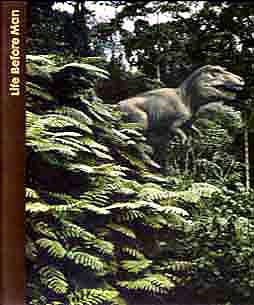
The first time I became explicitly aware of the emerging Dinosaur Renaissance was when I ordered the Time-Life book Life Before Man in 1972. Although not particularly well-illustrated, it discussed the work by this Robert Bakker fellow about how dinosaurs were energetic, food demanding and active beasts with four-chambered hearts that carried their tails clear of the ground. (My opinion of Mr. Harryhausen slipped when he claimed that tail in the air dinosaurs were just a fad and the tail draggers he used to animate would return to fashion. Check out the statistical science, Ray).
That made sense. A sickle clawed dromaeosaur was shown leaping on the back of a hapless tenontosaur. A stegosaur with flat rather than erect plates reared up to feed on a tree. One scene showed sauropods easily moving on land like an elephantine herd of adults and juveniles. On the other hand, Protoceratops was still laying eggs they buried and left to be eaten by Oviraptor.
Reprising Martin Luther King’s proclamation of “free at last,” in 1973 I finally escaped the quasi-prison that was grade school and happily began to attend Northern Virginia Community College (NOVA) where I was treated like an adult. (I had contacted Jim (Allosaurus) Madsen about attending the University of Utah under his tutelage, but he warned that the paleontology program had been gutted). That summer I got my first job at a pet store which made sense in that I like tropical fish. Alas I soon was under a manager whose biker appearance resembled Hagar the Horrible, and who boasted of participating in orgies (I am not making this up). The incompetent idiot ended up firing me and I started working at a now defunct drugstore chain. Access to university level libraries as well as that of the Geological Survey upped my level of scientific awareness and knowledge. Now I could peruse technical journals, including Nature which was carrying the early studies by Bakker, one contending that sauropods were giraffe-like browsers – which I disagreed with for a few years. And there was Dale Russell’s research on the super swift ornithomimids, and the big brained troodonts with stereo vision and manipulative hands.
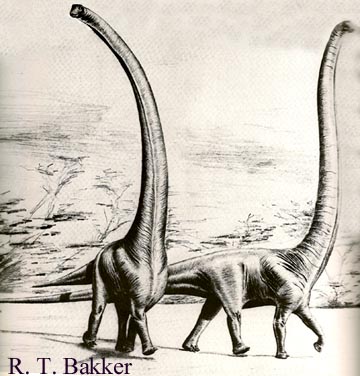 But it was not a technical periodical that let me know how profoundly things were changing. A brief blurb in Smithsonian told about how Bakker thought dinosaurs were “warm-blooded” like birds and mammals. It immediately made sense, my long mental conflict was resolved. That’s why dinosaurs were so like our feathered and furry friends – they had the same power system. And his Nature papers presented technical data backing his ideas up.
But it was not a technical periodical that let me know how profoundly things were changing. A brief blurb in Smithsonian told about how Bakker thought dinosaurs were “warm-blooded” like birds and mammals. It immediately made sense, my long mental conflict was resolved. That’s why dinosaurs were so like our feathered and furry friends – they had the same power system. And his Nature papers presented technical data backing his ideas up.
At NOVA I happily took Terry Dyroff’s geology course that covered the parallel revolution in geology as continental drift was proven during the '74-75 session. In April I was heading towards the new scientific journals stacks at the library when I sighted the startling and enticing cover of the latest Scientific American. My excitement rose as I perceived the bright green and bizarre Longisquama cover illustration, with the title “Dinosaur Renaissance.” There was only one person who could be behind this. Sure enough it was Bakker. With Sarah Landry’s furry therapsids in Paleozoic African snows, and the first illustration of a feathered dinosaur, and Syntarsus chasing a gliding lizard down the slope of a dune.
Renaissance Men
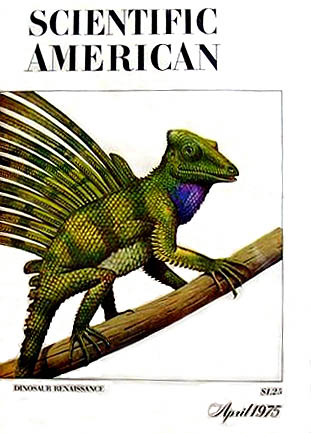 At the same time John Ostrom was producing the equally radical evidence that birds were not, after all, the remote relatives of dinosaurs, but their direct descendents. A few researchers were counter-arguing that birds were the offspring of the early, gracile crocodilians, but this hypothesis was patently inferior on anatomical grounds. It is difficult to get across how mentally transformative was the well-documented hypothesis that dinosaurs had not gone entirely extinct was but still existed in the feathered form of birds. In a few years the classical view of dinosaurs as long lost reptilian failures had been entirely wrecked, they still lived among us, competing with the mammals on a daily basis in the country and in the cities.
At the same time John Ostrom was producing the equally radical evidence that birds were not, after all, the remote relatives of dinosaurs, but their direct descendents. A few researchers were counter-arguing that birds were the offspring of the early, gracile crocodilians, but this hypothesis was patently inferior on anatomical grounds. It is difficult to get across how mentally transformative was the well-documented hypothesis that dinosaurs had not gone entirely extinct was but still existed in the feathered form of birds. In a few years the classical view of dinosaurs as long lost reptilian failures had been entirely wrecked, they still lived among us, competing with the mammals on a daily basis in the country and in the cities.
The impact on my art was immediate. After a few years of no production during the high school-college transition, I began to illustrate theropods with feathers, the first being (inaccurately) an Allosaurus attacking Diplodocus.
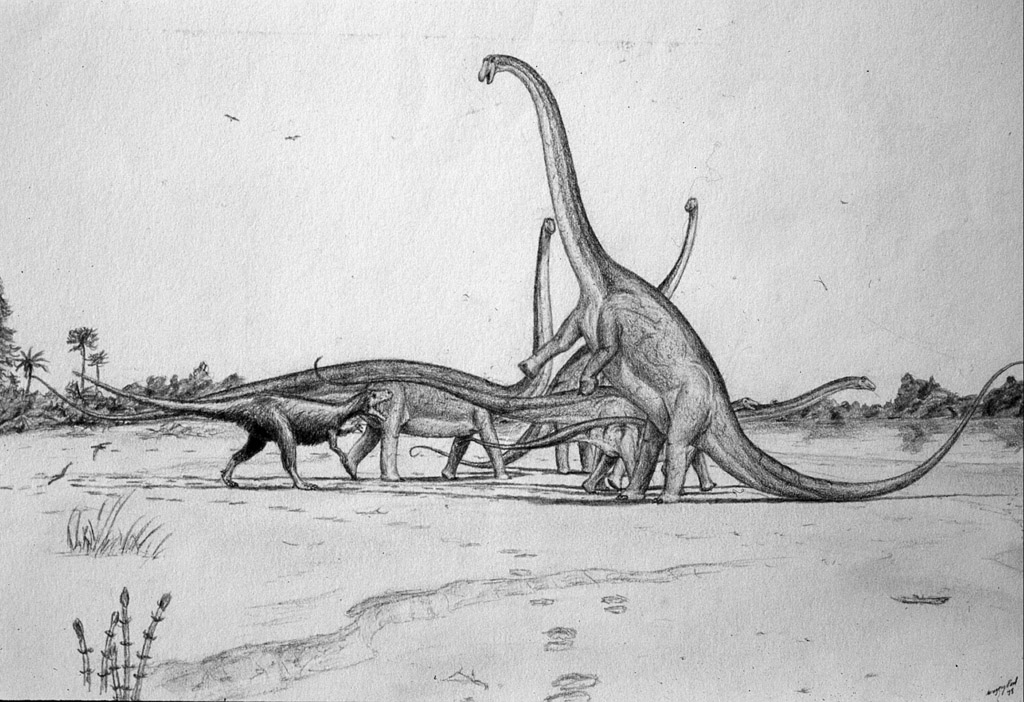 Until then all my paleoillustrations had been B&W, but I shifted in part to color pencils. The result were a burst of proto-portrayals of the “new look” of dromaeosaurs, troodonts, ornithomimids and other dinosaurs in 1976. Being obsolete these have long languished unused, but I am now starting to upgrade them to modern standards with some effective results. I was also making early attempts to do skeletal-muscle studies in the Matternes manner.
Until then all my paleoillustrations had been B&W, but I shifted in part to color pencils. The result were a burst of proto-portrayals of the “new look” of dromaeosaurs, troodonts, ornithomimids and other dinosaurs in 1976. Being obsolete these have long languished unused, but I am now starting to upgrade them to modern standards with some effective results. I was also making early attempts to do skeletal-muscle studies in the Matternes manner.
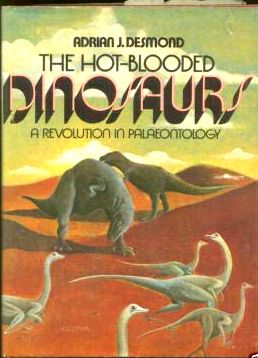 In 1976 I eagerly picked up Adrian Desmond’s The Hot-Blooded Dinosaurs at Walden Books in Tyson Corner’s mall. Began to read it in my Mach I Mustang (now there was a great car) waiting in a high school parking lot for Dr. Riddle’s (I don’t make these names up) NOVA astronomy class to start. That same spring, a friend of Dyroff who worked at the Smithsonian suggested I contact Nicholas Hotton. Off the letter went and no reply came. I was wondering what I had said wrong. Actually Nick was a notorious procrastinator. When I finally received a call inviting me to visit his office at the Smithsonian. Oh joy. I was doubly lucky, my visit coincided with that of Jack (Dr. Sauropod) McIntosh. The two affable professionals were enthusiastic about the illustrations I brought along. I would later learn that did not mean as much as I thought, paleontologists are generally poor judges of either the accuracy or quality of paleoart. I began to do some volunteer work, including prep work of fossils which I proved not particularly well-suited for, lacking the required patience.
In 1976 I eagerly picked up Adrian Desmond’s The Hot-Blooded Dinosaurs at Walden Books in Tyson Corner’s mall. Began to read it in my Mach I Mustang (now there was a great car) waiting in a high school parking lot for Dr. Riddle’s (I don’t make these names up) NOVA astronomy class to start. That same spring, a friend of Dyroff who worked at the Smithsonian suggested I contact Nicholas Hotton. Off the letter went and no reply came. I was wondering what I had said wrong. Actually Nick was a notorious procrastinator. When I finally received a call inviting me to visit his office at the Smithsonian. Oh joy. I was doubly lucky, my visit coincided with that of Jack (Dr. Sauropod) McIntosh. The two affable professionals were enthusiastic about the illustrations I brought along. I would later learn that did not mean as much as I thought, paleontologists are generally poor judges of either the accuracy or quality of paleoart. I began to do some volunteer work, including prep work of fossils which I proved not particularly well-suited for, lacking the required patience.
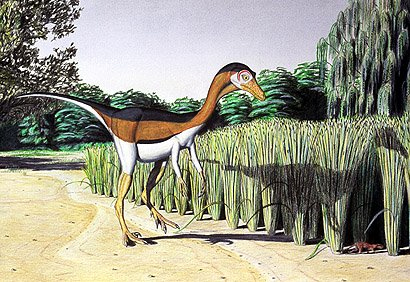
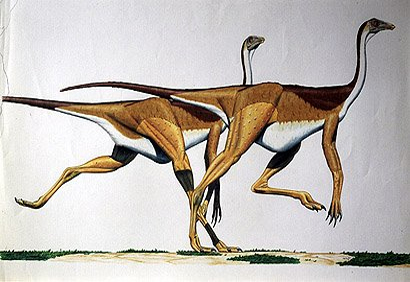
It was about this time I took a portfolio of my art to the Time-Life headquarters located in the area. The annoyed art editor dismissed my work as too amateurish. I was appalled by his callous arrogance, I knew my stuff was not that bad, and with years of experience I can see that some of it was superior to the illustrations they were publishing. There was also the largely forgotten Fossils Magazine affair. Ads promoting what was intended to be a first rate popular periodical went out, and I sent in my check. Then came the notices that due to assorted problems the first issue would be delayed and to please be patient. Finally it arrived and it was all it was promised to be. A trilobite embossed on the cover, lavish color illustrations and photographs inside. A Colbert article on drifting continents was illustrated by some new artist by the name of Mark Hallett. I sent in a long editorial debunking Bakker’s land bound sauropods yet I illustrated a pair of nose trunked Brachiosaurus walking across the Tendaguru landscape earlier that year, and the year before showed a feathered Allosaurus attacking a Diplodocus herd on land. Perhaps I was conflicted.

Nevertheless the editor accepted the piece. But it would never appear. Along came further notices asking for more patience. The production costs were too high for the limited audience and FM folded (Mike Fredericks would later avoid the cost problems with his less ambitious Prehistoric Times). By the end of the year I had switched over to terrestrial sauropods anyhow, and even agreed that the tail heavy beasts were adapted for feeding on two legs and a tail.
Early in 1977 the news went out. Public Television’s premier science program NOVA was going to cover the ongoing Dinosaur Revolution with The Hot-Blooded Dinosaurs. Wow. The first ever real documentary on dinosaurs. Double wow. And the first chance to see Bakker in those media primitive times. Expecting from readings of his technical studies a conservatively cut scientist, his Rasputin-like appearance was shocking. The program was very good. About the same time I learned Dr. Bob had become a professor at Johns Hopkins (in 1976). That was just up the road in Baltimore. I called his lab and got his graduate student Mike (Mr. Hadrosaur) Brett-Surman, who began to clue me in to Bakker’s irregular ways. I arranged to meet Bakker at the Smithsonian. He made numerous criticisms of my art. This time I listened. This guy actually knew something (an illustrator himself, Bakker’s criticisms were not artistic, but anatomical).
Soon after I visited his lab. This led to two items critical to my future art. Among Bakker’s skeletal restorations was a Triceratops done white bone on a solid black profile.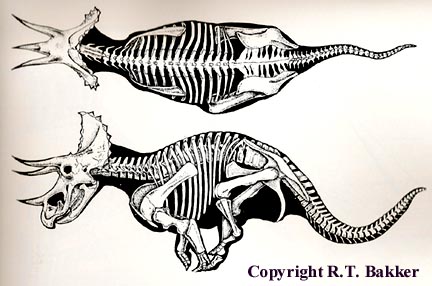
I do not know if Bob had picked this up from Knight and/or Scheele, and I was not aware of the former’s examples and had forgotten the latter’s. In any case, I liked the format and would began to use it myself. Second, at some point Bakker suggested I try out soft oil pencil on coquille board, which quickly became my B&W standard technique. Bakker soon began to commission illustrations for his upcoming book. I was thrilled!
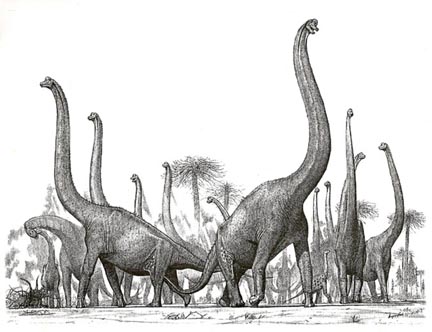
The book never was done. This led to what I consider my first professional illustration, the Brachiosaurus herd, inspired by an elephant herd scene by wildlife artist David Shepard, followed by a charging Triceratops trio, inspired by Frederic Remington scenes, as well as Bakker’s galloping Chasmosaurus pair.

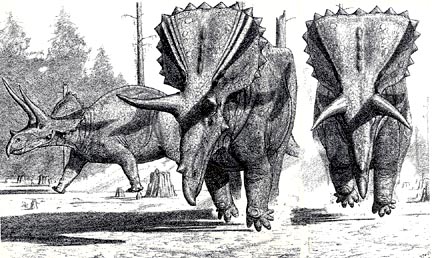
Following the big AAAS conference on hot-blooded dinosaurs, Science used my vignette of Ceratosaurus confronting an Allosaurus pair to accompany their article on the meeting in early 1978. My first professional dinosaur publication. Not long after, Natural History used the set of illustrations I had been doing for Bob to go along with Stephen Gould’s regular column, this one titled “Were Dinosaurs Dumb?” My first professional popular dinosaur publication. Gould would later cite my 'What Happens When Apatosaurus ajax Seeks Aquatic Refuge From Allosaurus fragilis' as an example of how art contributed to the dinosaur revolution.
An especially important event in my artistic evolution occurred in the fall of 1977. Over the years a few tentative attempts to learn to paint had failed. Decided to bite the bullet and sign up for a NOVA course on painting, expecting it to be another nebulous instruction that would prove futile. Fortunately the instructor was John Bannon, a local portrait artist who used and taught classic oil techniques. He started us out with just black and white to get us used to pushing the paint around and that went well. Then he plopped a beaten brass pot, a piece of pottery and a blown glass jar in front of me and I rolled my eyes at his expectation that I could do that. One week later I had a perfectly good still life and I was off and painting. Bannon was not all that happy that I turned my talents to dinosaurs rather than the standard fine art subjects (he was talking of a sojourn in Italy but I did not care.) My first paleo-painting was Pentaceratops herd, it too was influenced by the Shepard elephant scene. I got the towering head frills very wrong due to the insufficient data available at the time. Later updated and otherwise improved it remains a fine piece. Next year it would be the cover illustration of Laurence Pringle’s Dinosaurs and People, which also used some of my other output.
My next effort was a running Daspletosaurus, based on Russell’s accurately proportioned but less well-posed skeletal restoration. I was not satisfied with the forest background and later radically adjusted the work by replacing the woodlands with a cattail swamp and cloud-filled sky, while reconfiguring the animal in accord with a revised skeletal reconstruction. (Next)

